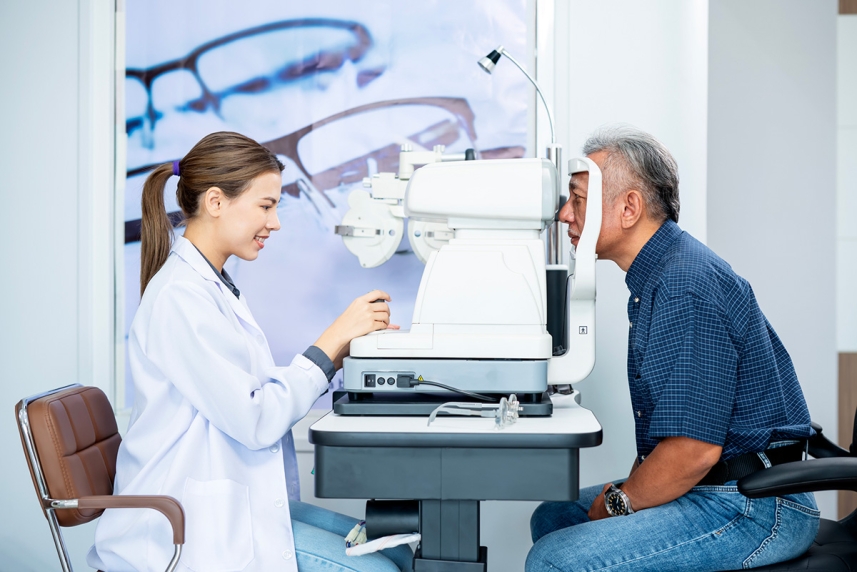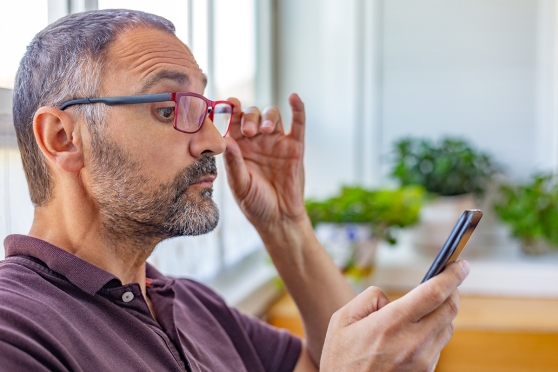6 ways people may prevent diabetic retinopathy
People with diabetes may be at risk of this serious vision condition. Find strategies to help delay — or avoid — its development.

A primary care physician or specialist may advise a person with diabetes to watch their blood sugar. But they may also refer them to an eye care provider to manage their eye health.
That’s because people who have type 1 or type 2 diabetes have a higher risk of developing diabetic retinopathy, a serious eye disease that may lead to blurred vision or even vision loss.1
Diabetic retinopathy also affects a lot of people: Almost 10 million people in the United States are estimated to have it. Of those millions, nearly 1 in 5 have the stage severe enough to threaten their eyesight.2
Diabetic retinopathy occurs when a person’s blood sugar levels are too high. That can damage the blood vessels in the retina (the layer of tissue at the back of the eye), causing them to leak. This may lead to changes in vision.3
One of the most challenging aspects is that people may not realize anything could be wrong, as early stages of diabetic retinopathy often have no noticeable no symptoms. The changes may be too subtle, and any could even be mistaken for natural signs of aging or other conditions.
For example, someone may have a harder time reading or seeing things at a distance.2 Over time, though, as the condition progresses, their symptoms may include blurry vision, spots or empty areas in the field of vision, trouble seeing colors, or vision loss.3
But people with diabetes may be able to avoid developing diabetic retinopathy — and if they do develop it, it still may be treatable. Here are 6 ways a person may prevent or curb the condition.
Stay on top of your eye health with an in-network provider. Search for an eye care provider now.
1. Follow a diabetes treatment plan
One of the best things a person with diabetes may do for their eyesight is to follow their care team’s treatment plan. A common plan could include things like:4
- Following a healthy diet
- Exercising more
- Medication
- Regular blood sugar testing
“Blood sugar control is really important for eye health when you have diabetes,” says Karin Underkoffler, O.D., an optometrist with Reliant Medical Group in Westborough, Massachusetts. A person may want to work with their health care provider to make sure they’re testing their blood regularly. That will be to check their A1C levels, or a measure of blood sugar levels over the past 3 months.5
Since diabetic retinopathy is caused by uncontrolled high blood sugar, regular testing may be a good way to keep the condition in check or better managed.
2. Monitor heart health
Diabetes can damage people’s blood vessels and cause damage to nerves that control the heart. So, people with diabetes have twice the risk of heart disease as those without it.6
Also, people with diabetes are more likely to have other conditions that raise the risk of heart disease, such as:6
- High blood pressure
- High cholesterol
- High triglyceride levels (a type of lipid, or fat, in the blood)
People with diabetes and high blood pressure or high cholesterol have a greater risk of diabetic retinopathy.1
“It’s important that people with diabetes keep the circulation going in the vascular system in the eye. Controlling blood pressure and managing lipid levels makes a difference in eye health, too,” says Dr. Underkoffler.
3. Schedule regular eye exams
People with diabetes may also want to see an eye care provider for a comprehensive, dilated eye exam at least once every year.1 It may be a good way to catch eye conditions such as diabetic retinopathy early.
An eye care provider may see and examine the blood vessels in the back of the eye, so they may watch for any changes, says Dr. Underkoffler. Sometimes, eye doctors may detect issues with blood sugar management before a person is even aware there is a problem.
While people with diabetes typically want to get an eye exam yearly, the right interval may be different for each patient. For example, if a person has vision problems, Dr. Underkoffler might ask them to come in once every 6 months for a vision exam.
It’s a good idea for people to talk to their eye care provider about what might be right for them. For example, a person may experience vision changes in between appointments such as:7
- Dark, floating spots or streaks
- Double vision
- Trouble seeing clearly or adjusting to changes in light or darkness
In that case, it may be a good idea to call their eye care provider right away.
4. Stay active
What’s good for the body may be good for the eyes too. Research shows that physical activity may delay diabetic retinopathy as well as decrease its severity.
Exercise may be protective and provide anti-inflammatory effects, which may help protect the retina.8 (That means it may improve the body’s immune response.) In addition, when you exercise, your muscle cells absorb blood sugar for energy. That effectively lowers blood sugar levels in the body and promotes healthy insulin function.9
What might keeping active look like? A person may not have to spend hours in the gym. There may be smaller ways to get the blood sugar benefits of exercise.
“Getting out and taking a walk every day improves A1C and circulation,” says Dr. Underkoffler. It may be good to aim for 30 minutes of moderate intensity physical activity, such as walking, on most days of the week, according to the Centers for Disease Control and Prevention.10
5. Quit smoking, or don’t start
Smoking affects more than just the lungs — it can harm the eyes too. In fact, smoking may be linked to the development of diabetic retinopathy, as well as other eye diseases, such as cataracts.3
“Smoking makes eye disease worse,” says Dr. Underkoffler. “I encourage patients to stop smoking — or don’t smoke to begin with.”
Also, smoking may make it more difficult for people with diabetes to manage their blood sugar. It can even make it harder for certain medications, such as insulin, to work effectively.11
A good first step to quitting could be to speak with their primary care provider. They could also call the free quit helpline at 1-800-QUIT NOW.11
6. Follow a healthy diet
Eating a healthy diet is one way someone with diabetes can manage their blood sugar levels. It may also promote good vision for people who may be aiming to prevent diabetic retinopathy.1
The American Diabetes Association recommends following the Diabetes Plate method, which could includes:12
- Filling half a plate with non-starchy vegetables
- One-quarter with carbohydrate foods (such as fruits or starchy vegetables)
- One-quarter with protein foods (such as lentils, eggs or salmon)
- Plus water or a zero-calorie drink
Even though this may be a new way to approach meals, it may be worth it to make these changes to keep the eyes healthy and protected.
Looking for a new eye care provider? Search the UnitedHealthcare Vision Network now.
Sources:
- Diabetic retinopathy National Eye Institute, last updated August 2024.
- Prevalence estimates for diabetic retinopathy (DR) Centers for Disease Control and Prevention, May 2024.
- Vision loss and diabetes Centers for Disease Control and Prevention, May 2024.
- Managing diabetes National Institute of Diabetes and Digestive and Kidney Diseases, October 2023.
- Testing for diabetes and prediabetes: A1C Centers for Disease Control and Prevention, May 15, 2024.
- Your heart and diabetes Centers for Disease Control and Prevention, May 2024.
- Promoting eye health Centers for Disease Control and Prevention, May 2024.
- Physical activity status and diabetic retinopathy: a review Cureus, August 2022.
- The role of exercise in diabetes Endotext, last updated January 2023.
- Get active Centers for Disease Control and Prevention, May 2024.
- Smoking and diabetes Centers for Disease Control and Prevention, last reviewed October 2023.
- Food and nutrition: tips for eating well American Diabetes Association.


